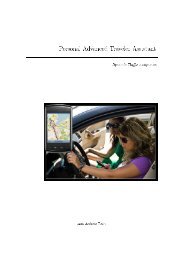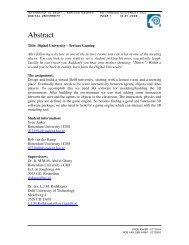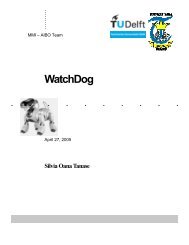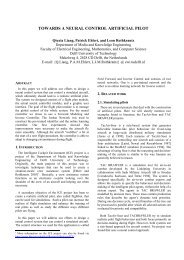Recognition of facial expressions - Knowledge Based Systems ...
Recognition of facial expressions - Knowledge Based Systems ...
Recognition of facial expressions - Knowledge Based Systems ...
You also want an ePaper? Increase the reach of your titles
YUMPU automatically turns print PDFs into web optimized ePapers that Google loves.
---------------------------------------------------------------<br />
1: P1 P2 P3 P4 P5 P6 P7 P8 P9 P10 Exp AU1 AU2 AU4 AU5 AU6 AU7 AU9 AU10 AU11 AU12 AU15<br />
AU16 AU17 AU18 AU20 AU21 AU22 AU23 AU24 AU25 AU26 AU27<br />
2: 3 4 3 5 1 1 3 2 3 5 Fear 1 1 0 0 0 0 0 0 0 0 0 0 0 0 1 1 0 0 0 1 0 0<br />
3: 4 5 5 7 4 3 3 5 6 2 Surprise 1 1 0 1 0 0 0 0 0 0 0 0 0 0 0 0 0 0 0 1 0 1<br />
4: 2 4 2 5 3 1 3 2 2 3 Sadness 0 0 1 0 0 0 0 0 0 0 0 0 1 0 0 0 0 0 0 0 0 0<br />
5: 2 3 2 3 1 1 3 2 2 2 Anger 0 0 1 0 0 1 0 0 0 0 0 0 1 0 0 0 0 1 1 0 0 0<br />
.............................................................<br />
483: 3 3 3 6 4 2 2 6 6 2 Surprise 0 0 0 1 0 0 0 0 0 0 0 0 0 0 0 0 0 0 0 1 0 1<br />
484: 3 3 2 2 1 1 2 1 2 6 Happy 0 0 0 0 1 1 0 0 0 1 0 0 0 0 0 0 0 0 0 1 0 0<br />
485: 3 3 2 4 1 1 2 1 2 6 Happy 0 0 0 0 1 1 0 0 0 1 0 0 0 0 0 0 0 0 0 0 0 0<br />
//---------------------------------------------------------------<br />
Listing 8. Final data extracted from the initial database (version II)<br />
For every row, the sequence <strong>of</strong> Action Units was encoded by using the value “1” for<br />
denoting the presence <strong>of</strong> the AU and “0” for absence. The discretization process for the<br />
given example was done on 7 classes per parameter basis. For the conducted<br />
experiments, there were also generated training files with 5 and 8 classes per parameter<br />
discretization.<br />
CPT Computation Application<br />
The application is used for determining the values in the table <strong>of</strong> conditioned<br />
probabilities for each <strong>of</strong> the parameters included in the Bayesian Belief Network.<br />
Initially, a BBN model can be defined by using a graphical-oriented application, as<br />
GeNIe. The result is a “XDSL” file that exists on the disk. The current application has<br />
been developed in C++ language. It parses an already made “XDSL” file containing a<br />
Bayes Belief network and analyses it. It also load the data related to the initial samples<br />
from the Cohn-Kanade database. For each <strong>of</strong> the parameters it runs some tasks as shown:<br />
- determines the parent parameters <strong>of</strong> the current parameter<br />
- analyzes all the states <strong>of</strong> the parent parameters and determines the all possible<br />
combination <strong>of</strong> the states<br />
- for each state <strong>of</strong> the current parameter, passes through each <strong>of</strong> the possible<br />
combinations <strong>of</strong> the parents and:<br />
o create a query that includes the state <strong>of</strong> the current parameter<br />
o add the combination <strong>of</strong> parent parameters<br />
- 76 -
















